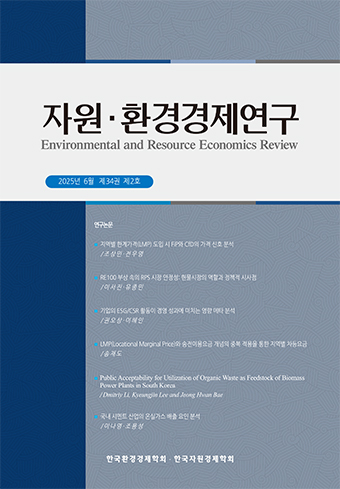Research Paper
Abstract
References
Information
In the circumstance of standing out the climate change issue, the purpose of this study is to compare the efficiency of offshore and coastal fisheries according to whether or not greenhouse gas (GHG) emissions are considered, and then to present policy alternatives based on the analysis results. For analysis, the traditional data envelopment analysis (DEA), the slacks-based measure (SBM) and the SBM-undesirable models were used, and robust analysis of variance (ANOVA) and Wilcoxon Signed-rank tests were performed. As a result, the study showed that the average efficiency of fisheries decreased as the traditional DEA extended to the SBM model considering the slack and the SBM-undesirable model including the GHG emissions. Specifically, the average efficiency of the traditional DEA model, SBM model, and SBM-undesirable model was analyzed as 0.7350, 0.5820 and 0.4976 respectively. In addition, the results of the robust ANOVA and Wilcoxon Signed-rank tests all showed that there are statistically significant differences in efficiency between offshore and coastal fisheries as well as among traditional DEA, SBM and SBM-undesirable models. As a policy alternative to the analysis, it was suggested that to improve the efficiency of coastal and offshore fisheries, it is necessary to actively implement the new fishing vessel project and develop smart and electric hybrid fishing vessels.
본 연구는 기후변화 이슈가 부각되는 환경에서 온실가스 배출량 고려 유무에 따른 연근해어업의 업종별 효율성을 비교하고, 분석 결과를 바탕으로 정책적 대안을 제시하는 데 목적이 있다. 분석을 위해 전통적인 자료포락분석(DEA) 모형과 잔여기반측정(SBM) 모형, 비소망재 SBM 모형을 이용하고, Robust Analysis of Variance (ANOVA) 검정과 Wilcoxon Signed-rank 검정을 시행하였다. 분석결과, 전통적인 DEA 모형에서 여분을 고려한 SBM 모형, 온실가스 배출량을 고려한 비소망재 SBM 모형으로 확장될수록 어업의 평균 효율성은 감소하는 것으로 분석되었다. 구체적으로 전통적인 DEA 모형과 SBM 모형, 비소망재 SBM 모형의 평균 효율성은 각각 0.7350, 0.5820, 0.4976으로 추정되었다. 또한 Robust ANOVA 검정과 Wilcoxon Signed- rank 검정결과, 전통적인 DEA, SBM, 비소망재 SBM 모형 간 효율성 차이와 근해어업과 연안어업의 효율성 차이도 통계적으로 유의하게 분석되었다. 분석의 정책적 대안으로, 연근해어업의 효율성 개선을 위해서는 신조어선사업의 적극적 시행과 함께 스마트어선 및 전기복합어선 개발 등이 필요함을 제안하였다.
- 강달원ㆍ정동훈ㆍ전승준, “유해산출물을 고려한 국내 공항 효율성 측정에 관한 연구”, 「한국항공운항학회」, 제26권 제4호, 2018, pp. 27~35.10.12985/ksaa.2018.26.4.027
- 김종천ㆍ박철형, “원양참치 연승 및 선망어업의 생산성 비교연구”, 「해양비즈니스」, 제42권 제1호, 2019, pp. 91~111.
- 김지우, “DEA/Window를 이용한 연근해어업의 주요업종별 효율성 비교 연구”, 「부경대학교 석사학위논문」, 2013, pp. 1~64.
- 김학수ㆍ박철형, “초효율성을 이용한 원양어업의 생산성분석”, 「해양비즈니스」, 제41권 제3호, 2018, pp. 1~20.
- 관계부처합동, “「2050 탄소중립」 추진전략”, 2020.
- 박만희, 『효율성과 생산성 분석』, 한국학술정보(주), 2008.
- 박철형, “연근해어업 업종별 생산성 추정에 관한 연구”, 「수산경영론집」, 제45권 제1호, 2014, pp. 63~77.10.12939/FBA.2014.45.1.063
- 박철형, “Super-SBM을 이용한 어항의 효율성분석에 관한 연구”, 「수산경영론집」, 제41권 제3호, 2010, pp. 129~151.
- 소순후, “비방사적 SBM 모형을 이용한 지역전략산업 기술개발투자의 효율성 분석”, 「산업경제연구」, 제24권 제2호, 2011, pp. 1169~1188.
- 수산업협동조합중앙회, 『2019년도 어업경영조사보고』, 2019.
- 신용민, 정겨운, “우리나라 근해어업의 배출 저감비용함수 추정”, 「자원ㆍ환경경제연구」, 제41권 제3호, 2018, pp. 399~420.
- 이정동ㆍ오동현, 『효율성분석이론』, 지필미디어, 2012.
- 이정민, “자료포락분석을 이용한 근해어업 생산성 비교 분석”, 「부경대학교 석사학위논문」, 2015, pp. 1~54.
- 이태휘ㆍ여기태, “탄소배출을 고려한 공항 효율성 측정에 관한 연구”, 「로지스틱스 연구」, 제23권 제3호, 2015, pp. 80~91.
- 에너지온실가스 종합정보 플랫폼, “이산화탄소배출량 산정식”, 2020, (http://www.tips.energy. or.kr).
- 전용한ㆍ남종오, “동태적 최적어업이론을 이용한 주요 연안어업의 온실가스 배출량 추정”, 「해양정책연구」, 제35권 제2호, 2020, pp. 23~51.
- 최수호ㆍ김민균, “DEA를 이용한 국내 항공사의 효율성 분석: 항공화물 및 환경요소를 중심으로”, 「로지스틱스 연구」, 2016, 제24권 제2호, pp. 46~61.
- 한국수산자원공단, 『근해어업실태조사』, 해양수산부, 2019.
- 한국수산자원공단, 『연안어업실태조사』, 해양수산부, 2019.
- 한정희, “DEA 모형을 이용한 발전회사 환경효율성에 대한 연구”, 「디지털융복합연구」, 제11권 제5호, 2013, pp. 119~133.
- 환경부, 『2019 국가 온실가스 인벤토리 보고서』, 2019.
- Amowine, N., Ma, Z., Li, M., Zhou, Z., Naminse, and E. Y., Amowine, J, “Measuring Dynamic Energy Efficiency in Africa: A Slack-Based DEA Approach,”
Energy Science & Engineering , Vol. 8, No. 11, 2020, pp. 3854~3865.10.1002/ese3.782 - Banker, R. D., A., Charnes, and W. W., Cooper, “Some Models for Estimating Technical and Scale Efficiencies in Data Envelopment Analysis,”
Management Science , Vol. 30, 1984, pp. 1078~1092.10.1287/mnsc.30.9.1078 - Cecchini, L., Venanzi, S., Pierri, A., and Chiorri. M, “Environmental efficiency analysis and estimation of abatement costs in dairy cattle farms in Umbria (Italy): A SBM-DEA model with undesirable output,”
Journal of Cleaner Production , Vol. 197, 2018, pp. 895~907.10.1016/j.jclepro.2018.06.165 - Charnes A., W. W. Cooper, and E. Rhodes, “Evaluating Program and Managerial Efficiency: An Application of Data Envelopment Analysis to Program Follow Through,”
Management Science , Vol. 27, No. 6, 1978, pp. 668~697.10.1287/mnsc.27.6.668 - Golany, B., and Y, Roll., “An application procedure for DEA,”
Omega , Vol. 17, No. 3, 1989, pp. 237~250.10.1016/0305-0483(89)90029-7 - Lin, X., Zhu., X., Han, Y., Geng, Z., and Liu, L.,“Economy and carbon dioxide emissions effects of energy structures in the world: Evidence based on SBM-DEA model,”
Science of the Total Environment , Vol. 729, 2020, pp. 1~9.10.1016/j.scitotenv.2020.138947 - Qi, H., Ji, H., Dabo, G., Zhifu, M., Hongyan, Z., and Qiang, Z., “The comprehensive environmental efficiency of socioeconomic sectors in China: An analysis based on a non-separable bad output SBM,”
Journal of Cleaner Production , Vol. 176, 2018, pp. 1091~1110.10.1016/j.jclepro.2017.11.220 - Shin, C. H, and Jeong, D. H., “Data Envelopment Analysis for Container Terminals Considering an Undesirable Output – Focus on Busan Port & Kwangyang Port,”
Journal of Korean Navigation and Port Reserch , Vol 37, No. 2, 2013, pp. 195~201.10.5394/KINPR.2013.37.2.195 - StataCorp, “STATA USER’S GUIDE RELEASE 16,”
A Stata Press Publication , 2019. - Tone, K, “A slacks-based measure of efficiency in data envelopment analysis,”
European Journal of Operational Research , Vol. 130, No. 3, 2001, pp. 498~509.10.1016/S0377-2217(99)00407-5 - Tone, K, “Dealing with Undesirable Output in DEA: A Slacks-based Measure (SBM) Approach,”
GIRPS Research Report Series I-2003-0005 , 2003, pp. 1~16.
- Publisher :Environmental and Resource Economics Review
- Publisher(Ko) :자원 · 환경경제연구
- Journal Title :자원·환경경제연구
- Journal Title(Ko) :Environmental and Resource Economics Review
- Volume : 30
- No :1
- Pages :79-105
- DOI :https://doi.org/10.15266/KEREA.2021.30.1.79



 자원·환경경제연구
자원·환경경제연구






